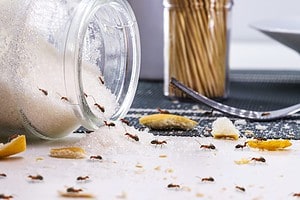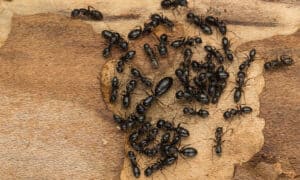Ants become major pests when they invade your home, and finding a trail marching across your kitchen countertop or swarming around your food is a frustrating sight. While commercial ant repellents and pesticides are available, many people prefer to use natural methods to get rid of ants inside their homes.
Discover 10 natural and effective ways to get rid of ants inside your home and strategies to keep your home ant-free. Say goodbye to chemical sprays and welcome eco-friendly solutions that work.
What Causes Ants in Your Home?
Ants can find their way into your home for various reasons, and understanding these causes can help you prevent infestations. Here are some common factors that lead to ants invading your living space:
- Food sources: Ants are attracted to food, especially sugary, greasy, or protein-rich items. Leaving crumbs, spilled liquids, or uncovered food in your kitchen can easily attract these pests.
- Water: Like all living creatures, ants need water to survive. Leaky pipes, dripping faucets, or areas with high moisture levels create a welcoming environment for ants.
- Shelter: Ants seek shelter from extreme weather conditions, such as excessive heat or rain. They enter your home through cracks, gaps, or openings in search of a haven.
- Scouts: Ants often send scout ants to explore new territories. If these scouts find favorable conditions inside your home, they will communicate with the colony and lead more ants inside.
- Nesting: Certain ant species may establish nests within walls, under floors, or in hidden cavities of your home. These nests can grow rapidly if left unchecked.
- Scent trails: Ants use chemical scent trails to communicate and navigate. Once they locate food or water sources in your home, they leave these trails, which can attract more ants.
- Seasonal changes: Ants tend to be more active during specific seasons, such as spring and summer, when they forage for food and establish new colonies.
Understanding these causes can help you identify potential entry points and take proactive measures to prevent ant infestations in your home.
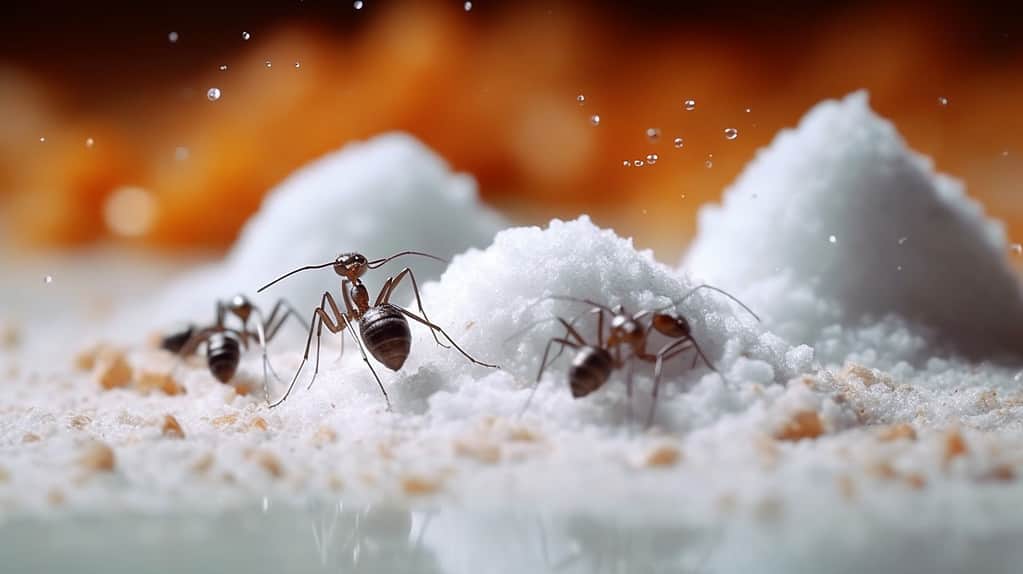
There are more than 12,000 species of ants worldwide, and many of them can find their way into homes.
©A-Z-Animals.com/
10 Natural Ways to Get Rid of Ants
Ant infestations can be a persistent nuisance in our homes, but there is no need to resort to harsh chemicals to keep them at bay. Discovering effective, natural ways to get rid of ants can help you maintain a pest-free environment while prioritizing the safety of your family and pets.
1. Borax and Sugar Solution
Borax, a common household cleaning agent, is a powerful tool in your battle against ants when combined with sugar. The sugar attracts the ants, while the borax disrupts their digestive system, ultimately leading to their demise. Here’s how to create and use this effective natural ant bait:
Step 1: To make the borax and sugar solution, mix equal parts of borax and granulated sugar in a bowl. For example, you can start with one tablespoon of borax and one tablespoon of sugar. This ratio ensures that ants are attracted to the bait while ingesting the borax.
Step 2: Identify the ant trails and entry points in your home. These are typically where you’ll find the most ant activity. Place small amounts of the borax and sugar mixture near these areas, ensuring it is easily accessible to the ants.
Step 3: After setting out the bait, resist the urge to clean up any ant trails or dead ants immediately. Allow the ants to carry the bait back to their nest. This process may take some time, as worker ants share the bait with the colony.
Step 4: Check the bait stations regularly and replenish them as needed. It is essential to keep a fresh supply of the borax and sugar mixture available to continually attract and eliminate ants.
Step 5: While borax is generally considered safe when used as a pesticide, it should be kept out of reach of children and pets. Ensure that the bait stations are placed in areas inaccessible to curious hands or paws.
Using borax and sugar as a natural ant control method can be highly effective, especially for sugar ants. It is an efficient way to target the entire ant colony, ultimately preventing future infestations.
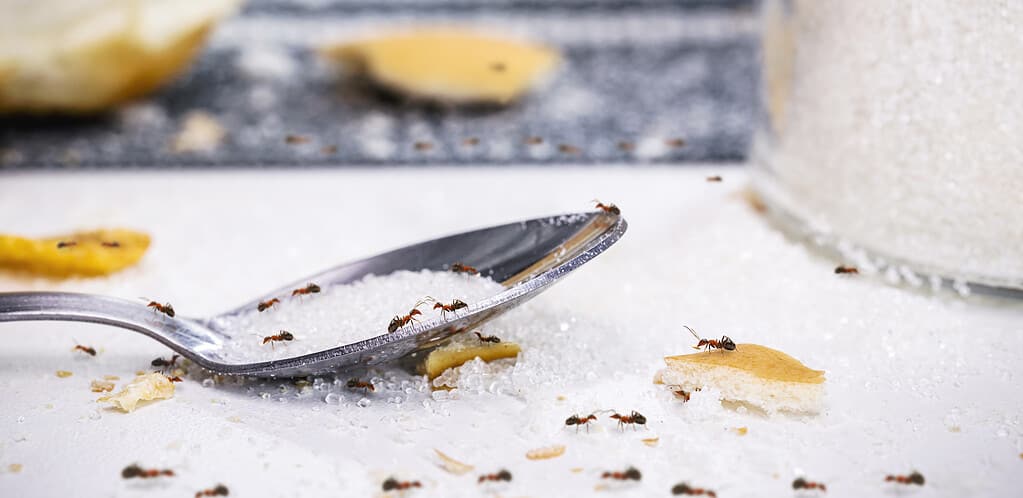
Ants are incredibly strong for their size. Some species can carry objects up to 50 times their own body weight.
©iStock.com/RHJ
2. Vinegar Solution
Vinegar, a pantry staple, is a potent natural ant repellent due to its strong odor and acidic properties. This method is also safe for households with children and pets. Here’s how to create and use a vinegar solution to deter ants:
Step 1: You need white vinegar and water to make the solution. Mix equal parts of vinegar and water by combining one cup of vinegar with one cup of water and pouring the solution into a spray bottle.
Step 2: Before applying the solution, identify the ant trails and entry points in your home. These are the areas where ants are most active.
Step 3: Spray the vinegar solution directly onto ant trails, entry points, and any areas where you have seen ants. The strong odor of vinegar disrupts their trails and discourages them from entering those areas.
Step 4: Reapply the vinegar solution as needed, especially after cleaning or if you notice ants returning. This may be necessary, as the scent of vinegar can dissipate over time.
Step 5: In addition to using the vinegar solution as a deterrent, consider using it to clean surfaces and areas where ants are likely to forage for food, such as kitchen countertops. This helps eliminate the scent trails that attract ants.
Pro tip: Be cautious when using vinegar on sensitive surfaces like natural stone countertops, as it can potentially damage them. Test a small, inconspicuous area before widespread application.
It is important to be patient when using the vinegar solution. While it is a natural and safe method, it may take some time to completely deter ants from your home, especially if they have a well-established colony.

Ants are highly social insects and work together in colonies. A single colony can consist of thousands or even millions of ants.
©focal point/Shutterstock.com
3. Diatomaceous Earth
Diatomaceous earth, often referred to as DE, is a natural and non-toxic substance made from the fossilized remains of microscopic algae called diatoms. It is also an effective natural remedy for dealing with ants and other crawling insects.
Diatomaceous earth works by physically damaging the exoskeleton of ants and other insects, dehydrating them and ultimately leading to their death. It’s a mechanical rather than a chemical action, making it safe for humans and pets. Here’s how to use food-grade diatomaceous earth to get rid of ants:
Step 1: Ensure you purchase food-grade diatomaceous earth, which is safe for use around humans and pets. Avoid using pool-grade DE, which is chemically treated and not suitable for this purpose.
Step 2: Locate the areas where ants are entering your home or where you’ve seen their trails. Common entry points include cracks, crevices, and gaps around doors and windows.
Step 3: Using a dusting applicator or a small handheld duster, lightly apply a thin layer of diatomaceous earth along ant trails, entry points, and areas where you’ve spotted ants. Pay special attention to cracks and crevices.
Step 4: DE is a fine powder. When applying it, wear a mask to avoid inhaling the dust. Additionally, keep pets and children away from the application areas until the dust settles.
Step 5: Diatomaceous earth can lose its effectiveness when it becomes wet or clumps together. Therefore, you need to reapply the dust after rain or in humid conditions. Reapply as necessary until the ant problem is resolved.
Step 6: Use DE indoors and outdoors to address ant infestations. When using it outdoors, focus on the areas where ants are entering your home or where they are congregating.
Overall, diatomaceous earth is an environmentally friendly and safe method for getting rid of ants. It is particularly effective against crawling insects and is a preferred option for those seeking natural pest control solutions.

Ants are known for their efficiency in foraging. They can locate and carry food back to their nests quickly.
©FotoHelin/Shutterstock.com
4. Lemon Juice
Lemon juice’s citrus scent and natural acidity deter ants and keep them away from your home. Here’s how to use it effectively:
Step 1: Squeeze fresh juice from lemons. Fresh lemon juice tends to be more potent than store-bought lemon juice, but either can work.
Step 2: Mix the lemon juice with an equal amount of water in a spray bottle. This dilution ensures that the lemon juice is effective without being too harsh on surfaces.
Step 3: Before applying the lemon juice solution, identify the areas where ants are most active. These are typically ant trails, entry points, and areas where you’ve seen ants foraging for food.
Step 4: Spray the lemon juice and water solution. Be sure to focus on:
- Spray the solution directly onto ant trails, disrupting their scent pathways. This makes it difficult for ants to navigate and find food sources.
- Apply the solution to entry points such as door frames, windowsills, and gaps or cracks where ants might be entering your home.
- Lastly, focus on areas where you’ve noticed ant activity, such as your kitchen or pantry.
Step 5: Lemon juice can lose its effectiveness as it dries and its scent fades. Reapply the solution as needed, especially after cleaning or if ants return.
Pro tip: Lemon juice also serves as a natural cleaning agent in areas where ants forage for food. Its acidity can help remove scent trails that attract ants.
Using lemon juice as a natural ant deterrent is a safe and eco-friendly way to keep ants away from your home. It is a cost-effective and readily available solution that can help you maintain an ant-free environment without resorting to harmful chemicals.

Ants often follow established scent trails, creating well-defined paths between their nests and food sources, earning them the nickname “ants on a march.”
©Africa Studio/Shutterstock.com
5. Citrus Peels
Use citrus peels, such as those from lemons, oranges, and grapefruits, as a natural and aromatic method to deter ants from entering your home. Just follow a few simple steps:
Step 1: Save the peels from citrus fruits after you have used the fruit or enjoyed a refreshing citrus snack. These peels contain natural oils and scents that ants find repulsive.
Step 2: Simply place citrus peels, particularly lemon or orange peels, near ant entry points, windowsills, and countertops. Replace the peels as their scent fades, typically every few days.
You can also mash the peels slightly to release more of their oils and scent. Place the mashed peels in areas where ants are most active.
Step 3: Over time, the scent from the citrus peels will diminish. Replace them or add more mashed peels to maintain their effectiveness.
Step 4: Use citrus peels as a preventive measure to keep ants from entering your home in the first place. Regularly placing peels in potential entry points can discourage ants from establishing trails.
Pro tip: Beyond its ant-repelling properties, the fresh and pleasant citrus scent can also serve as a natural air freshener in your home.
Using citrus peels is a natural, safe, and pleasant-smelling way to deter ants from entering your home. It provides an eco-friendly alternative to chemical pesticides while helping you maintain an ant-free environment.

Most ant species are omnivores, consuming a variety of foods, including nectar, insects, fruits, and even other ants.
©Elizabeth A. Cummings/Shutterstock.com
6. Essentials Oils
Essential oils are concentrated extracts from plants that you can use as natural ant repellents due to their strong scents and various properties. Here’s how to effectively use essential oils:
Step 1: Choose essential oils with known ant-repelling properties. Some effective options include:
- Peppermint oil: Known for its strong and refreshing scent, peppermint oil is a potent ant repellent.
- Lemon oil: The citrusy scent of lemon oil can deter ants effectively.
- Tea tree oil: Tea tree oil has antifungal and antibacterial properties that can help deter ants.
- Lavender oil: Lavender oil not only repels ants but also has a calming scent for your home.
Step 2: Essential oils are highly concentrated and should be diluted before use to prevent skin irritation. Mix a few drops of your chosen essential oil with water or a carrier oil like coconut oil or jojoba oil. The specific dilution ratio may vary, but a common guideline is five to ten drops of essential oil per ounce of water or carrier oil.
Step 3: Fill a spray bottle with your diluted essential oil solution. Shake it well to ensure proper mixing.
Step 4: Spray the essential oil solution. Focus on:
- Apply the solution directly onto ant trails, entry points, and areas where ants are active.
- Additionally, focus on areas where you’ve seen ants foraging for food, such as kitchen countertops, pantry shelves, and around pet food dishes.
- Lastly, another method is to soak cotton balls in the diluted essential oil solution and place them strategically near ant entry points and ant trails.
Pro tip: You can also use essential oil diffusers to disperse the scent of ant-repelling essential oils throughout your home, creating a continuous deterrent.
Essential oils are generally safe for humans and pets when properly diluted. However, some individuals may be sensitive to certain oils. Always exercise caution, especially around pets, and ensure good ventilation when using essential oils.
You can also experiment with different essential oil blends to find the one that works best for your specific ant problem and suits your preference for scent.

Ants communicate through a combination of pheromones and physical movements. They leave chemical trails for others to follow.
©botamochi/iStock via Getty Images
7. Cinnamon
Cinnamon is a popular spice with a pleasant and aromatic scent that can also serve as a natural ant deterrent. Here’s how to use cinnamon effectively:
Step 1: You can use ground cinnamon or cinnamon sticks, which are readily available in most kitchens and stores.
Step 2: Sprinkle ground cinnamon directly along ant trails, entry points, and areas where ants are active. This creates a physical barrier that ants are reluctant to cross due to the strong scent.
Optionally, place cinnamon sticks or pieces near ant entry points, windowsills, and countertops. These sticks release a consistent cinnamon scent to deter pests.
Step 3: Cinnamon can lose its effectiveness as its scent fades, so reapply it as needed, especially after cleaning or if ants return.
Step 4: Consider using cinnamon as a preventive measure to discourage ants from entering your home. Regularly sprinkling cinnamon near potential entry points can deter ants from establishing scent trails.
Pro tip: Cinnamon adds a warm and inviting aroma to your living spaces, making it a pleasant choice for scenting your indoor space. Consider cinnamon-scented diffusers and candles for everyday use.

Queen ants can live for several years, while worker ants have shorter lifespans, ranging from a few weeks to a few months.
©iStock.com/jirkaejc
8. Coffee Grounds
Coffee grounds are another easily accessible substance that can be repurposed to deter ants from entering your home. Here’s how to use them for ant control:
Step 1: Collect used coffee grounds after brewing your morning coffee. Fresh grounds can also work, but used grounds are more effective due to their strong, residual scent.
Step 2: Sprinkle the used coffee grounds directly along ant trails, entry points, and areas where ants are active. The strong aroma of coffee can disrupt their scent trails.
Additionally, create coffee barriers by outlining areas where you want to prevent ants from crossing. This can be particularly useful for protecting food storage areas.
Step 3: Coffee grounds can lose their effectiveness as their scent fades, so reapply them as needed, especially after cleaning.
Pro tip: You can also use coffee grounds outdoors to deter ants from entering your home. Place them around the perimeter of your house or in areas where ants are likely to enter.
Coffee grounds are safe for humans and pets. Repurposing used coffee grounds for ant control is an eco-friendly way to reduce waste while addressing ant infestations.

Some ant species are invasive and can disrupt local ecosystems when introduced to new areas. Examples include the Argentine ant and the red imported fire ant.
©iStock.com/Michelle Lee Photography
9. Bay Leaves
Like cinnamon sticks, you can also use common bay leaves to deter ants and other pests. Here’s how:
Step 1: Collect dried bay leaves, which are readily available in grocery stores or can be harvested from a bay laurel tree if you have one.
Step 2: Simply place dried bay leaves near ant entry points, windowsills, and countertops. Replace them as they dry out, typically every few weeks.
Additionally, crush a few dried bay leaves to release more of their aroma, then place them in areas where ants are most active.
Step 3: Over time, the scent from the bay leaves will diminish. Replace them or add more crushed leaves to maintain their effectiveness.
Bay leaves add a pleasant and subtle aroma to your living spaces, making them an appealing choice for scenting your home. However, it may take some time for the scent to take full effect.
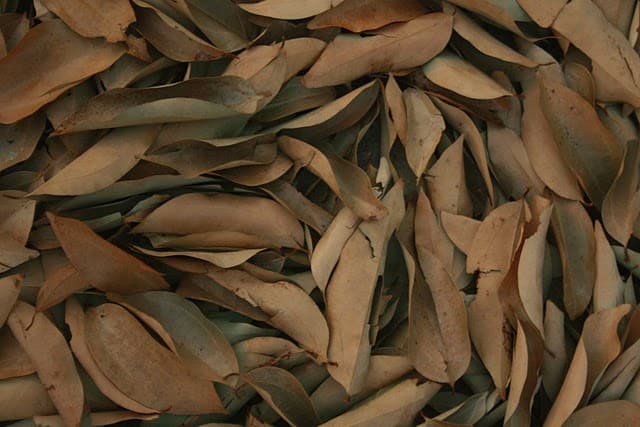
People often keep ant farms as educational tools. These setups allow observers to see how ants construct tunnels and manage their colonies.
©Sagar.kolte, CC BY-SA 3.0 , via Wikimedia Commons – Original / License
10. Cornstarch
Cornstarch is another common kitchen ingredient that you can use to deter ants. Here’s how to use cornstarch effectively:
Step 1: Before applying cornstarch, identify the areas where ants are most active. These are typically ant trails, entry points, and areas where ants are foraging for food.
Step 2: Sprinkle cornstarch directly along ant trails, entry points, and areas where ants are active. Cornstarch interferes with ants’ ability to move, making it difficult for them to navigate.
Additionally, create cornstarch barriers by outlining areas where you want to prevent ants from crossing. This can be particularly useful for protecting food storage areas.
Step 3: Reapply it as needed, especially after cleaning or if ants return. Cornstarch is safe for humans and pets.

While ants in homes can be a nuisance, they can also be fascinating to observe. Their organized behavior and tireless work ethic make them intriguing subjects for study.
©Dhe Tong/Shutterstock.com
Common Household Ants
Identifying the species of ants that you are dealing with is a crucial step in effective ant control. Different ant species have distinct behaviors, nesting habits, and preferences. Identifying the specific species allows you to tailor your approach for more effective control. What works for one species may not be as effective for another.
Additionally, misidentifying ants can lead to ineffective or even counterproductive control measures. For example, methods suitable for sugar ants may not work against carpenter ants, and vice versa. Mismanagement can also cause the ant infestation to worsen.
Furthermore, using targeted methods based on ant species reduces the need for broad-spectrum chemical pesticides, helping to minimize the environmental impact. This approach aligns with eco-friendly and sustainable pest control practices.
Common Household Ant Species
Here are a few common household ant species that you may encounter:
- Sugar ants (odorous house ants): These small, brown ants are attracted to sugary substances. They leave a noticeable, sweet, rotten odor when crushed. They also require baiting methods to effectively control their colonies.
- Carpenter ants: Carpenter ants are larger ants, often black or red, that can cause structural damage by tunneling into wood. Identifying them early is crucial to prevent costly damage to your home. Carpenter ants don’t typically consume wood but excavate it to create nests.
- Fire ants: Fire ants are aggressive and deliver painful stings. They are typically reddish-brown and build distinctive mounds. Fire ants require specialized treatments.
- Pharaoh ants: Pharaoh ants are tiny, pale ants often found in kitchens and bathrooms. They are notorious for being difficult to control and require careful attention to detail.
- Pavement ants: These ants are small, brown to black ants that commonly nest under pavement cracks or rocks. Find them foraging for food in kitchens and other indoor areas.
- Argentine ants: Argentine ants are small, light to dark brown ants that form massive colonies. They are challenging to control due to their large numbers and interconnected nests.
- Black house ants: Find these small, black ants in and around homes. They are attracted to sweets and other food sources.
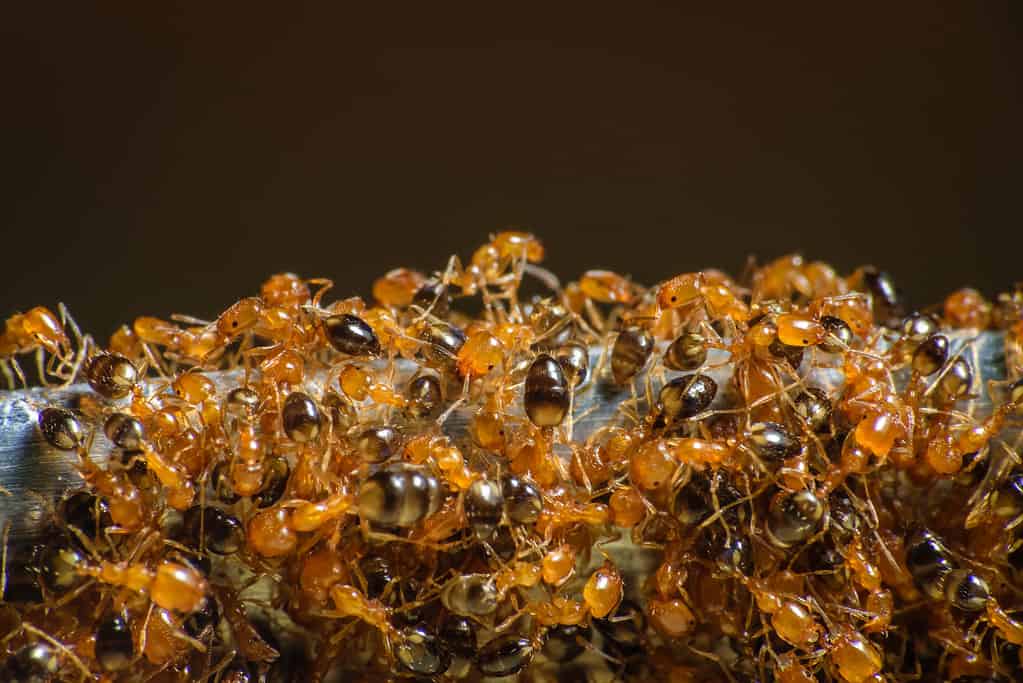
Pharaoh ants are only 1.5 to 2 millimeters long, making them one of the smallest ant species in the world.
©Suman_Ghosh/Shutterstock.com
Natural Repellents for Specific Ant Species
Knowing which type of ant you are dealing with allows you to choose the most effective natural control methods, as well as adopt preventive measures tailored to the specific species. Natural repellents for specific ant species include:
Sugar Ants (Odorous House Ants)
Peppermint oil: Sugar ants dislike the strong scent of peppermint. Mix a few drops of peppermint essential oil with water and spray it along ant trails and entry points.
Vinegar: Wipe down surfaces with a vinegar solution (equal parts vinegar and water) to erase scent trails and discourage sugar ants.
Carpenter Ants
Diatomaceous earth: Sprinkle food-grade diatomaceous earth around suspected nesting areas and entry points. The abrasive particles can damage the ants’ exoskeleton and dehydrate them.
Borax and sugar solution: Create bait by mixing equal parts of borax and a sweet substance like sugar or honey. Place it near carpenter ant trails. They’ll carry the bait back to the nest, eventually eradicating the colony.
Fire Ants
Boiling water: For outdoor mounds, carefully pour a pot of boiling water directly onto the mound to kill fire ants. Do this in the evening when they are less active.
Diatomaceous earth: Apply food-grade diatomaceous earth to the mound to dehydrate and kill the fire ants.
Pharaoh Ants
Borax and sugar solution: Like carpenter ants, create a bait using sugar and borax. Place it in areas where you’ve seen pharaoh ants. They’ll carry it back to their colony.
Pro tip: Pharaoh ants are attracted to food sources. Ensure all food is stored in airtight containers.
Pavement Ants
Cinnamon: Sprinkle ground cinnamon along ant trails and entry points. Pavement ants dislike the scent and will avoid it.
Vinegar: Wipe down surfaces with a vinegar solution to erase scent trails and deter pavement ants.
Argentine Ants
Diatomaceous earth: Apply food-grade diatomaceous earth around ant entry points and areas with activity.
Vinegar: Spray a mixture of vinegar and water along ant trails and entry points.
Black House Ants
Chalk: Draw a line with chalk at ant entry points. Black house ants won’t cross the calcium carbonate barrier.
Lemon juice: Wipe surfaces with lemon juice to eliminate scent trails and deter blackhouse ants.
Remember that persistence and consistency are key when dealing with ant infestations. Regularly reapply these natural repellents and seal food sources to maintain a pest-free environment. Additionally, good sanitation practices and sealing entry points can help prevent ant infestations in the first place.
Pros and Cons of Natural Ant Control Solutions
When it comes to dealing with ant infestations, natural solutions offer several advantages, but they also come with some limitations.
Pros:
- Safety: Natural remedies are non-toxic and safe for pets, children, and the environment.
- Cost-effectiveness: They are generally inexpensive and budget-friendly.
- Minimal environmental impact: They do not contribute to chemical pollution.
Cons:
- Slower results: Natural methods may not be as immediately effective as chemical treatments, requiring more time to see results.
- Persistence required: They often need repeated applications to maintain effectiveness, which can be time-consuming.
Natural ant control solutions offer safety, cost-effectiveness, and eco-friendliness as their main benefits. Nevertheless, they may require patience and persistence to achieve the desired results, especially in more significant infestations.
Natural and Effective Ant Control for a Peaceful Home
Nature offers a wealth of powerful allies when you are battling ants and other pests in your home. From simple ingredients in your kitchen to botanical repellents and strategic preventive measures, embracing natural solutions can help you bid farewell to ant infestations while creating a safer and healthier living environment. With patience, consistency, and a touch of nature, you can keep your home ant-free and enjoy the home you deserve.
The photo featured at the top of this post is © Cherkas/Shutterstock.com
Thank you for reading! Have some feedback for us? Contact the AZ Animals editorial team.




